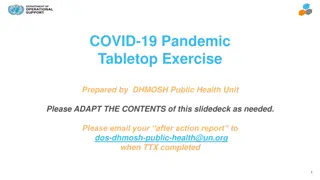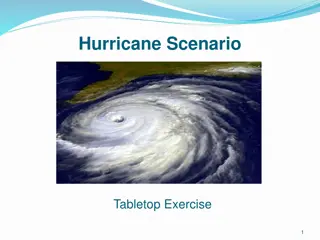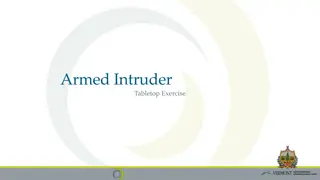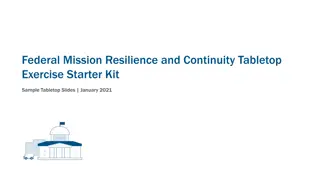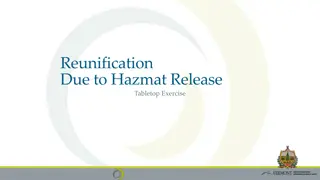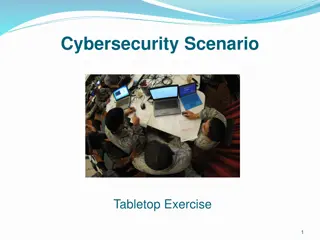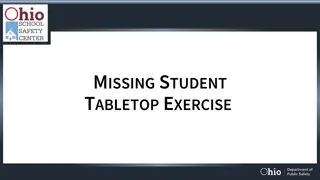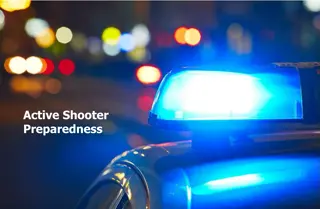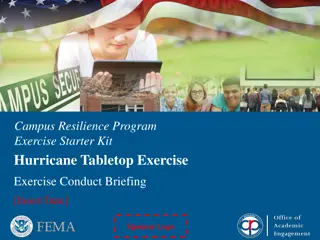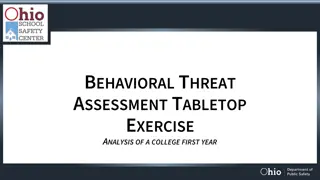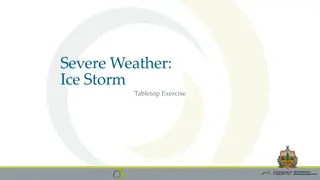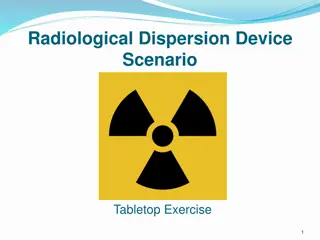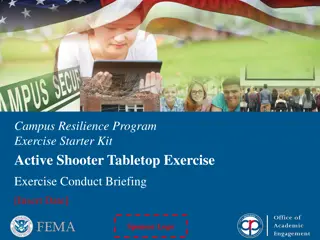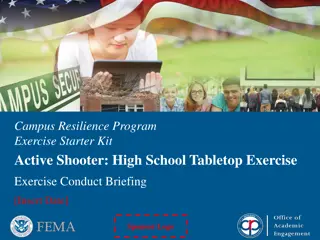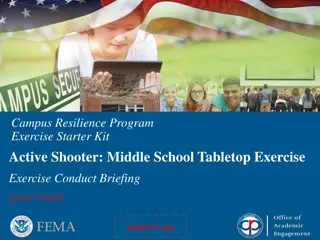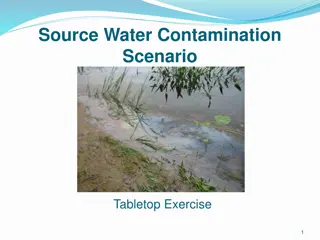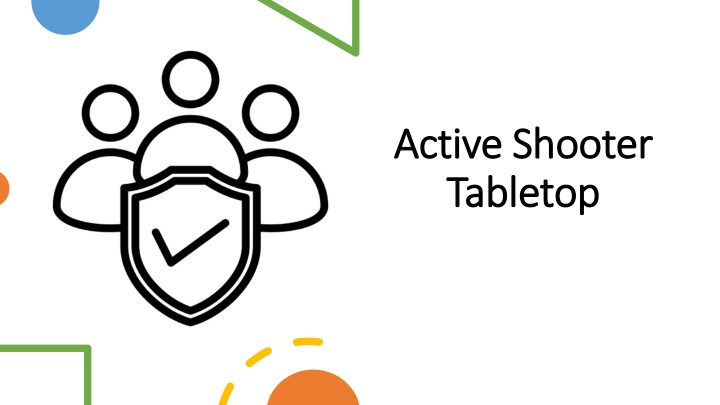
Active Shooter Preparedness: Legal, Ethical, and Tactical Insights
Gain insights into navigating the legal and ethical landscape surrounding active shooter incidents. Explore tabletop exercises, organizational philosophies, and mental exercises. Delve into tribal and institutional knowledge for a comprehensive approach to preparedness.
Download Presentation

Please find below an Image/Link to download the presentation.
The content on the website is provided AS IS for your information and personal use only. It may not be sold, licensed, or shared on other websites without obtaining consent from the author. If you encounter any issues during the download, it is possible that the publisher has removed the file from their server.
You are allowed to download the files provided on this website for personal or commercial use, subject to the condition that they are used lawfully. All files are the property of their respective owners.
The content on the website is provided AS IS for your information and personal use only. It may not be sold, licensed, or shared on other websites without obtaining consent from the author.
E N D
Presentation Transcript
Active Shooter Active Shooter Tabletop Tabletop
Objectives Objectives Understand the legal and ethical landscape Learn Go through a scenario involving an active shooter Observe [Insert any relevant policies] Gaps: Identify Planning Capability Capacity
Approach Approach The outcome is impacted by our planning, capacity and capabilities. I am the facilitator this time. Keep your own notes. Take notes about things we need to do and other observations. Think not only about your sphere of influence but about the whole company. You are acting as you during this exercise.
Mental Mental Exercise Exercise What is the one foolproof way to make sure you have fully planned for an act of violence?
Mental Exercise Mental Exercise What is the one foolproof way to make sure you have fully planned for an act of violence? Trick question. It is not possible to plan for an act-of-violence. We can provide very general guidelines for before or following an act-of-violence, we cannot give any absolutes on how to react while the incident is transpiring. Why? Because planning and absolutes assume that you possess ALL of the details of such an incident and, this is impossible because acts-of-violence are like snowflakes - there are no two alike. If we plan or give absolutes without details, and we are wrong about even a very small aspect of the incident, the results could be worse than had we never even considered security at all.
Legal & Ethical Landscape [Insert Legal Resource s Name & Title if applicable]
Legal Landscape Legal Landscape [Insert your legal counsel s guidance on this topic]
Ethical Landscape Ethical Landscape [Insert your guidance on this topic]
Tribal v. Institutional Knowledge Tribal Information that professionals know and understand combined with their knowledge of the organization, people, technology and process. Leaves the organization when a person leaves the organization. Institutional Documented, normalized, and maintained in the form of plans, policy, procedure, training and guidelines. Stays in the organization regardless of changes in personnel, departments, and technologies.
Whats happening? What s happening? It s Friday, 1PM. Tammy is an administrative assistant. Her partner, Dave, arrives and asks for her. The practice manager asks Dave to leave, Dave is upset at the request, but he does leave the building. Earlier, Tammy was visibly upset by an argument with Dave before work. She shut off her phone because of repeat, disruptive calls from Dave. Dave sits in his car for quite a while, which the front desk staff take notice of.
Think about Think about Does this sound concerning? Or not? What s your reaction? Who monitors this type of situation? What would you do? Who has the authority and skills to investigate if something doesn t seem right? Who responds to concerns and alerts?
Whats happening? What s happening? 01 02 03 It s 1:15. The front desk staff have moved on they have a whole line of patients being checked in. Dave arrives back in the building. He has a rifle visible in his hand. Dave tells a PSR to get Tammy now.
What Now? What Now? Some PSRs have gone under their desk for cover. Two patients in the waiting room are yelling. Who can you alert? How? Do you need to evacuate patients? Staff? How would you do it? Are you supposed to evacuate? Or stay and help others? Is the response tribal or institutional knowledge?
Whats happening? What s happening? 2 minutes later, Dave shoots at the door to get past the waiting room. A PSR dials 911 from their cell phone under the desk. There is total panic in the waiting room; a few people were knocked down by the boyfriend. Chaos is starting as providers and staff behind badge swipes try to figure out if they heard a car backfire or a firecracker or
[information from Emergency Action Plan if applicable] Run, Hide, Fight (if applicable) Here s where our plan is put into action We don t know where everyone is in the building. We don t know what Dave might do. Three things we need to do: Get safe Get help Return to normal
What is our processes for operating after a scary and potentially life-threatening situation? What will you do with the incoming calls from concerned patients, press, staff, etc.? Do those processes rely on specific people, tech, or other resources? Are they still available? How long will you close/reduce hours if staff are unable to work or your physical location has damage? Who needs communication immediately? What can be delayed? Business Business Continuity Continuity (Return to normal; keep business running)
Next steps and additional materials Next Steps Next Steps Identify action items Review your notes What can be addressed immediately? Read relevant policies Read site-specific evacuation plan and make suggestions for your site Any infrastructure or budget constraints to discuss? Review at leadership meetings how to have preparedness discussions with staff Communicate evacuation plan to staff Continue important discussions at Safety Committee and each site This is a collective effort and we each must make this a priority to have an impact Report back to your safety committee rep to review at safety meeting Consider training for staff
Was this useful? What did you learn? What can you take back to your team? What did you think? Questions?


